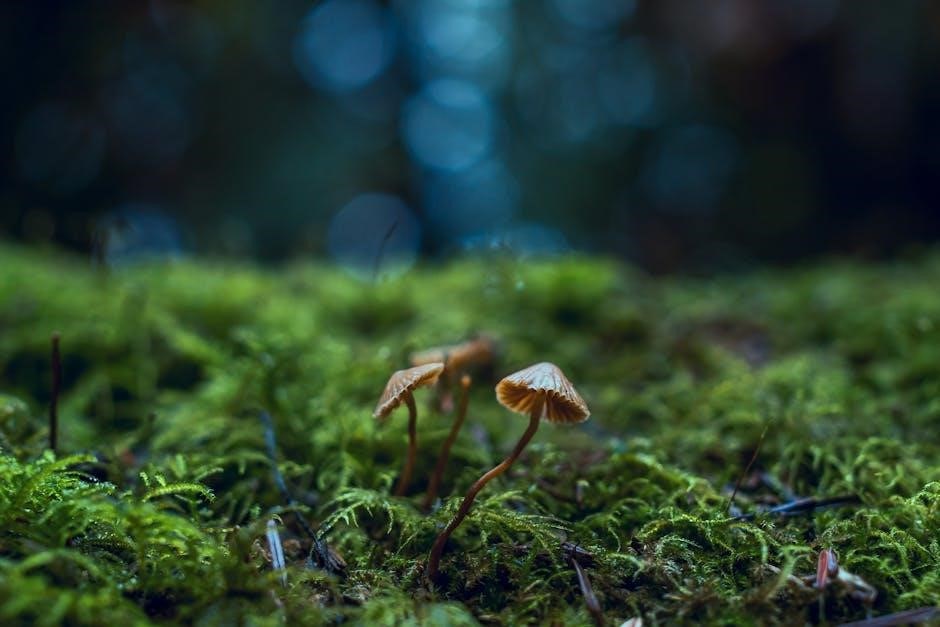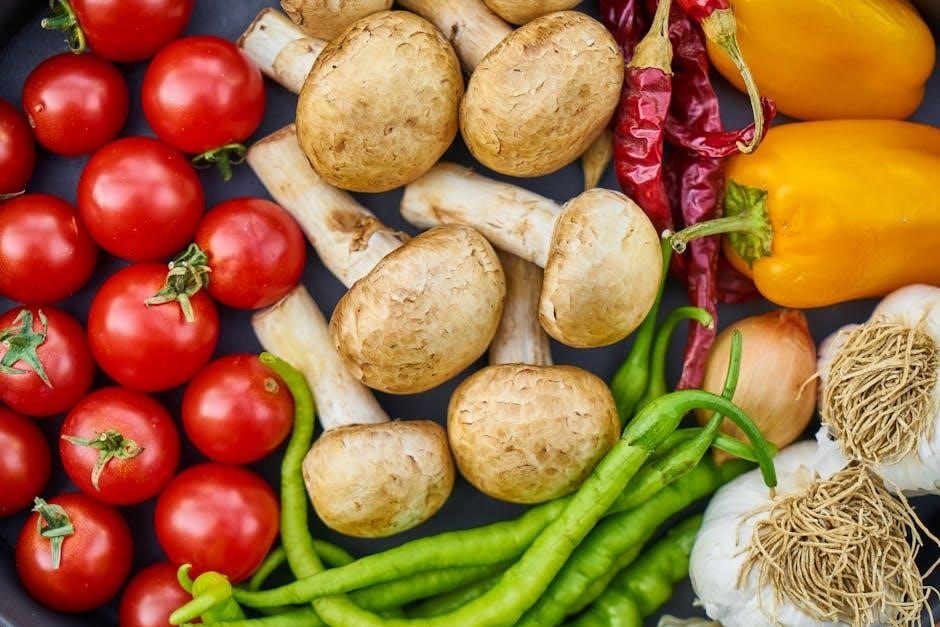Mycology, the scientific study of fungi, explores their biology, ecology, and applications. It encompasses mushrooms, yeasts, and molds, vital for medicine, food, and environmental balance.
1.1 What is Mycology?
Mycology is the scientific study of fungi, including their structure, growth, reproduction, and ecological roles. It examines diverse species, from edible mushrooms to medicinal fungi, and their interactions with environments. This field also explores fungi’s importance in decomposition, nutrient cycling, and symbiotic relationships. Mycology has practical applications in medicine, agriculture, and food production, making it a vital area of biological research. Understanding fungi’s biology and behavior helps humanity harness their benefits while mitigating potential risks.
1.2 Importance of Studying Fungi
Studying fungi is essential for understanding their ecological, medical, and culinary roles. Fungi are key decomposers, aiding nutrient cycling in ecosystems. They form symbiotic relationships with plants, enhancing soil fertility. Medicinal breakthroughs, like antibiotics, originate from fungi. Additionally, edible mushrooms are a nutritious food source, while others have potential therapeutic benefits. Understanding fungi also helps mitigate risks from poisonous species and harness their industrial applications, making mycology vital for environmental sustainability and human well-being.

Mushroom Identification
Mushroom identification involves recognizing species based on shape, size, color, and habitat. It is crucial for safety, as some species are poisonous. Key features like gills, caps, and spore prints aid in accurate identification.
2.1 Key Characteristics for Identification
Identifying mushrooms relies on observing key features such as shape, size, color, and habitat. The cap shape, gill or pore structure, stem length, and presence of a veil are critical. Spore prints, obtained by placing a mushroom cap on white paper, reveal spore color, aiding identification. Other traits include odor, texture, and how the mushroom reacts to cutting or bruising. Accurate observation of these characteristics is essential for distinguishing safe, edible species from potentially harmful ones.
2.2 Advanced Identification Techniques
Advanced mushroom identification involves specialized tools and methods. Microscopic analysis of spores and tissue structures provides detailed insights. Chemical tests, such as applying potassium hydroxide (KOH) to observe color reactions, can help identify species. Additionally, molecular techniques like DNA sequencing are increasingly used for precise identification. Experts often combine field observations with laboratory analysis to confirm species. These methods ensure accuracy, especially for rare or look-alike species, and are essential for serious mycologists and researchers seeking reliable identifications.

2.3 Role of Spore Prints in Identification
Spore prints are crucial for mushroom identification. By placing a mushroom cap on white paper and covering it, spores fall, creating a pattern. The color, ranging from white to dark brown, helps narrow down species. This method, often combined with microscopic analysis, provides essential details about spore shape and size. Accurate spore prints are vital for distinguishing between similar species, ensuring safe and correct identification, especially for edible or poisonous varieties. This simple yet effective technique is a cornerstone in mycological studies and fieldwork;
2.4 Digital Tools for Mushroom Identification
Digital tools have revolutionized mushroom identification, offering accessible and precise methods. Apps like Shazam for Mushrooms and iNaturalist use AI to analyze images, providing quick species matches. Online databases, such as MushroomExpert.com, host extensive libraries for comparison. Forums and social media groups connect enthusiasts, enabling collaborative identification. These tools enhance traditional methods, making mycology more accessible while ensuring accuracy. However, they should always be used alongside field guides and expert consultation to confirm findings, especially for edible or poisonous species.

Edible Mushrooms
Edible mushrooms are a diverse group, prized for their unique flavors and textures. Popular varieties include button, cremini, and shiitake, each enhancing various cuisines. Correct identification is crucial for safe consumption.
3.1 Popular Edible Mushroom Species
Some of the most beloved edible mushrooms include button, portobello, and shiitake. Button mushrooms are mild and versatile, perfect for salads and sauces. Portobellos, with their meaty texture, are ideal for grilling. Shiitake mushrooms, native to East Asia, offer a rich, earthy flavor and are commonly used in stir-fries. Other popular varieties include cremini and oyster mushrooms, each bringing unique characteristics to various dishes. These species are widely cultivated and enjoyed globally for their distinct tastes and culinary adaptability.
3.2 Foraging for Wild Edible Mushrooms
Foraging for wild edible mushrooms can be a rewarding adventure but requires careful attention to detail. Correctly identifying species is crucial, as some mushrooms are poisonous. Use field guides, consult experts, and avoid unsure finds. Popular wild edibles include morels and chanterelles, often found in forests and grasslands. Ensure sustainability by harvesting responsibly, leaving enough for ecosystems to thrive. Always prioritize safety and knowledge to enjoy the bounty of wild mushrooms responsibly.
3.3 Culinary Preparation of Edible Mushrooms
Culinary preparation of edible mushrooms enhances their flavor and texture. Roasting brings out earthy notes, while sautéing adds crispiness. Fresh mushrooms can be used immediately, while dried varieties require rehydration. Pairing them with herbs, cheeses, or meats elevates dishes, making mushrooms a versatile ingredient. They are also a healthy addition, rich in nutrients, and can be incorporated into vegetarian and vegan diets. Experimenting with different methods allows for a wide range of creative and delicious meals.
3.4 Safety Precautions for Consumption
When consuming edible mushrooms, safety is paramount. Never eat unidentified species, as some are poisonous. Always consult an expert to ensure accurate identification. Be aware of lookalikes and avoid mushrooms showing signs of decay. Proper preparation is essential—rehydrate dried mushrooms fully and cook thoroughly to break down toxins. Allergic reactions can occur, so start with small portions. Avoid mixing mushrooms with alcohol or medications. Prioritize sourcing from trusted suppliers or reputable foraging guides to minimize risks.

Poisonous Mushrooms
Poisonous mushrooms pose significant health risks if ingested. Some species, like the death cap, can cause severe illness or fatalities. Accurate identification is crucial to avoid deadly mistakes.
4.1 Common Poisonous Species
Several mushroom species are highly toxic and dangerous to humans. The death cap (Amanita phalloides) is among the most lethal, causing liver and kidney failure. Destroying angels (Amanita virosa) are equally deadly. False morels (Gyromitra esculenta) contain toxins that can cause severe poisoning. Conocybe filaris and Autumn skullcap (Galerina marginata) are also deadly. Some species, like the poisonous panther (Amanita pantherina), can mimic edible mushrooms, making accurate identification critical. Expert guidance is essential to avoid life-threatening mistakes when foraging for wild mushrooms.
4.2 Symptoms of Mushroom Poisoning
Symptoms of mushroom poisoning vary depending on the species but often include nausea, vomiting, diarrhea, and abdominal pain within hours of ingestion. Severe cases may involve confusion, hallucinations, or liver and kidney damage. Some mushrooms, like the death cap, can cause symptoms to progress rapidly, leading to organ failure. Delayed reactions, such as liver dysfunction, may occur days later. Immediate medical attention is crucial, as early treatment can significantly improve outcomes and prevent fatal results; Always consult an expert before consuming any wild mushroom to avoid such risks.
4.3 Emergency Response to Poisoning
If someone ingests a potentially poisonous mushroom, stay calm and act quickly. Contact a poison control center or a medical professional immediately for guidance. Do not induce vomiting unless instructed by an expert. Administering activated charcoal may help if advised. Provide detailed information about the mushroom if possible. Seek emergency medical attention without delay, as timely treatment is critical. Remember, professional medical advice is essential in such situations to ensure the best outcome and prevent severe complications.

Culinary Uses of Mushrooms
Mushrooms add rich, earthy flavors to dishes, from soups to sauces. They can be roasted, sautéed, or microwaved, enhancing meals with their versatility and nutritional benefits.
5.1 Cooking Methods for Mushrooms
Mushrooms can be prepared using various methods to enhance their flavor and texture. Roasting brings out their rich, earthy notes, while sautéing adds a tender crispiness. Microwaving offers a quick option for a healthy snack. For dried varieties, rehydration in boiling water restores their freshness. Whether roasted solo or paired with other ingredients, mushrooms elevate dishes with their versatility and nutritional benefits, making them a culinary delight in any form.
5.2 Pairing Mushrooms with Other Ingredients
Mushrooms complement a wide range of flavors, enhancing dishes with their earthy notes. Pairing them with garlic, herbs, and cheeses creates rich, savory profiles. Shiitake mushrooms excel in Asian-inspired dishes, while Porcini shines in Italian cuisine with butter and sage. Their umami flavor pairs beautifully with meats like steak or poultry, and they add depth to vegetarian recipes. Whether combined with creamy sauces or fresh greens, mushrooms elevate meals, offering a versatile and flavorful addition to any culinary creation.
5.3 Nutritional Value of Mushrooms
Mushrooms are a nutrient-dense food, offering significant health benefits. They are low in calories and fat but rich in essential vitamins like D and B, along with minerals such as copper and selenium. Many species, like shiitake and oyster mushrooms, contain antioxidants and beta-glucans, which support immune function. Their high fiber content aids digestion, while their umami flavor enhances meals without adding excess salt or sugar. This makes mushrooms a versatile and nutritious addition to a balanced diet, providing both flavor and health advantages.
Health Benefits of Mushrooms
Mushrooms are renowned for their beneficial properties, supporting immune function, mental well-being, and overall health through their unique combination of nutrients and bioactive compounds.
6.1 Medicinal Properties of Mushrooms
Mushrooms possess remarkable medicinal properties, including immune-boosting compounds like beta-glucans and antioxidants. Certain species, such as reishi and chaga, are known for their anti-inflammatory and detoxifying effects. Psilocybin mushrooms are being studied for their potential in treating mental health disorders, while others, like cordyceps, may enhance physical performance and reduce fatigue. The bioactive molecules in mushrooms contribute to overall well-being, making them a valuable resource in both traditional and modern medicine.

6.2 Role in Boosting Immune System
Mushrooms are rich in beta-glucans and antioxidants, which play a significant role in enhancing immune function. These compounds stimulate the production of immune cells, such as macrophages and natural killer cells, helping the body combat pathogens. Species like reishi, chaga, and shiitake are particularly noted for their immune-boosting properties. Regular consumption of these mushrooms can reduce inflammation and improve overall immune resilience, making them a natural and effective way to support health and prevent illness.
6.3 Mental Health and Microdosing
Mushrooms, particularly psilocybin species, are gaining attention for their potential in mental health. Microdosing involves consuming sub-perceptual amounts to enhance mood, focus, and creativity. Studies suggest reduced anxiety and depression in some users. Psilocybin interacts with serotonin receptors, promoting neural plasticity and emotional resilience. While research is ongoing, many report improved well-being. However, it’s crucial to approach microdosing cautiously and consult professionals to ensure safe and effective use. This practice highlights mushrooms’ emerging role in mental health and personal growth.

Mushroom Cultivation
Mushroom cultivation involves growing fungi on specific substrates like straw or wood. It requires controlled environments with optimal temperature, humidity, and light to promote healthy mycelium growth and fruiting.
7.1 Basics of Growing Mushrooms
Growing mushrooms begins with obtaining high-quality mushroom spawn, which is the material used to propagate mycelium. The substrate, such as straw or wood chips, must be sterilized to prevent contamination. Inoculation involves introducing the spawn into the substrate under clean conditions. Maintaining optimal temperature, humidity, and light is crucial for mycelium growth. Once colonized, the substrate is moved to a fruiting environment. Monitoring for contaminants and ensuring proper airflow are essential steps. Patience is key, as the process from inoculation to harvest can take several weeks.

7.2 Substrates and Growing Mediums
Substrates are the base materials on which mushrooms grow, providing nutrients for mycelium development. Common substrates include straw, wood chips, compost, and agar. Each material has specific preparation requirements, such as sterilization or pasteurization, to eliminate contaminants. Straw is ideal for oyster mushrooms, while wood-based substrates suit species like shiitake. Compost is typically used for button mushrooms, and agar is often employed in laboratory settings for pure mycelium cultivation. The choice of substrate depends on the mushroom species, climate, and desired yield, ensuring optimal growth conditions.
7.3 Maintaining Optimal Growing Conditions
Mushroom cultivation requires precise environmental control. Temperature, humidity, and light levels must be carefully managed to suit the specific species. Most mushrooms thrive in temperatures between 55°F and 60°F, with humidity maintained at 70-90%. Proper airflow is essential to prevent CO2 buildup and contamination. Lighting should be minimal, as excessive light can inhibit growth; Regular monitoring of these conditions, along with sterilization of equipment, ensures a healthy mycelium and fruitful harvest. Consistent maintenance schedules are critical for maximizing yield and quality.
Safety and Legal Considerations
Mushroom use varies in legality worldwide, especially for psilocybin species. Always research local laws and exercise caution. Consulting experts before consumption is crucial for safety.
8.1 Legal Status of Psilocybin Mushrooms
The legal status of psilocybin mushrooms varies globally. In some regions, like Oregon, they are decriminalized for personal use, while others, such as many European countries, permit limited medical research. Under UN conventions, psilocybin is classified as a Schedule I controlled substance, restricting its use. However, certain countries have decriminalized possession in small quantities. Laws are evolving, with growing interest in therapeutic potential. Always verify local regulations before considering use or cultivation to ensure compliance with current legal frameworks and avoid legal consequences.
8.2 Responsible Use of Psychedelic Mushrooms

Responsible use of psychedelic mushrooms involves careful preparation and awareness. Start with low doses to assess sensitivity and ensure a safe, guided experience. Set and setting are crucial—choose a calm environment and a trusted guide. Avoid mixing with alcohol or other substances. Educate yourself on potential risks and benefits. Consult healthcare professionals, especially for pre-existing conditions. Follow legal guidelines and ethical practices. Microdosing, popular for mental clarity, should be approached cautiously. Use reputable sources and consider community resources for support and guidance to ensure a positive and safe experience.
Mushrooms offer vast potential in cuisine, medicine, and ecology. Responsible foraging and safety are paramount. Explore their benefits with caution, respecting nature and legal guidelines always.
9.1 Final Tips for Mushroom Enthusiasts
For mushroom enthusiasts, safety and knowledge are key. Always consult experts before consuming any species. Prioritize sustainable foraging to protect ecosystems. Join online communities for shared insights and stay updated on legal guidelines. Experiment with culinary recipes to unlock their flavors. Consider microdosing for mental well-being but under professional guidance. Lastly, embrace the fascinating world of fungi with curiosity and respect, ensuring responsible exploration and use for generations to come.
Additional Resources
Explore recommended books, online forums, and databases for deeper insights. Websites like mushroomexpert.com and Ultimate-Mushroom.com offer comprehensive guides and expert advice.
10.1 Recommended Reading
For a deeper dive, explore books like “Mushrooms Demystified” by David Arora and “The Mushroom Hunters” by Langdon Cook. Online resources like mushroomexpert.com and Ultimate-Mushroom.com provide extensive databases and identification guides. Field guides such as the National Audubon Society Field Guide to Mushrooms are invaluable for practical use. Additionally, academic journals like Mycologia offer scientific insights, while online forums like the Shroomok community foster discussion and shared knowledge among enthusiasts.
10.2 Online Communities and Forums
Engage with online communities like the Shroomok community and forums such as r/mycology on Reddit to connect with enthusiasts. Platforms like iNaturalist allow users to share findings and learn from experts. Ultimate-Mushroom.com hosts discussions on cultivation and identification, while specialized groups focus on topics like microdosing and psychedelic experiences. These spaces provide valuable resources, expert advice, and shared knowledge for both beginners and seasoned mycologists, fostering a collaborative learning environment.

No Responses